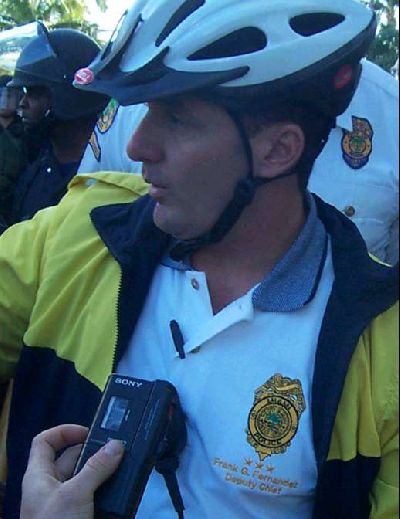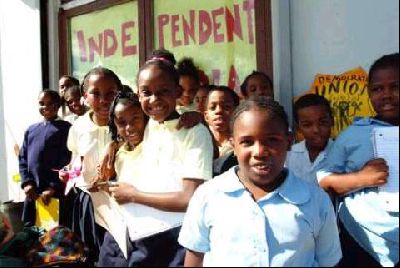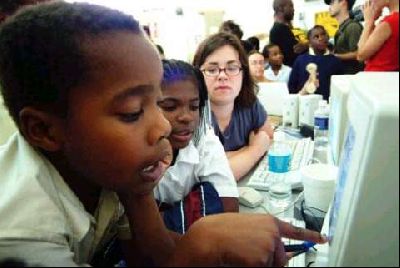Baltimore IMC : http://www.baltimoreimc.org
LOCAL Commentary :: Activism : Civil & Human Rights : Globalization : Media : Protest Activity
The Miami Model: Observations on a Corporate and Government Alliance
After the FTAA demonstrations, Miami Mayor Manny Diaz called the actions “a model for homeland security.” This article uses a chronological framework to characterize the Miami Model in broad terms as a system of integrated elements including propaganda, intimidation, brute force, arrest, detention, and use of the justice system.
.
.
This piece is built upon a multi-media presentation given by Baltimore global justice movement activist Mike McGuire. He spoke at the People's Summit on January 24, 2004, sponsored by the University of Baltimore Progressives...See People's Summit article
In November 2003, international trade ministers met in Miami, Florida for negotiations on the proposed Free Trade Area of the Americas (FTAA). The FTAA would effectively expand the North American Free Trade Agreement (NAFTA) to cover the 34 countries in the Western Hemisphere, except Cuba.
Opposition to the FTAA is founded on a concern that these agreements are established by and for the interests of large multinational corporations without meaningful public involvement. These agreements institutionalize unfair advantages, which undermine social wellbeing. Current and future lives and livelihoods are at stake. These grave stakes justify street demonstrations, protected by basic democratic principles.
This is a story about how government and corporate entities collaborated to deny basic democratic rights of expression in Miami. Local, state and federal authorities used an integrated sequence of actions designed to undermine dissenting political voices before, during and after the FTAA demonstrations. Miami Mayor Manny Diaz called the actions “a model for homeland security.” Several cities sent law enforcement observers to Miami to study what some are now referring to as the “Miami Model.”
Many of the People's Summit workshop participants expressed being shocked by the new information they received in McGuire's presentation. A show of hands revealed that only a few, of about fifty people, were aware of the harsh realities that transpired in Miami. The void of meaningful news coverage is an indictment of the corporate media. During her speech at the recent World Social Forum, Arundhati Roy said, “It's important to understand that the corporate media don't just support the neoliberal project. They are the neoliberal project. This is not a moral position they have chosen to take; it's structural. It's intrinsic to the economics of how the mass media work.” This notion was cleverly exploited as part of the Miami Model.
The Miami Model Architect
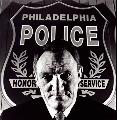
The Miami Model was conceived and implemented by John F. Timoney. Timoney, presented by the media as “Miami Chief of Police,” was actually on temporary leave from Beau Dietl & Associates, an investigative and security corporation. This blurring of the line between the government and corporations is an unsettling trend, motivating people like Robert F. Kennedy Jr. to ponder the slide of America toward “corporate fascism.” McGuire described Timoney's controversial history, notably as Philadelphia Police Commissioner during the 2000 Republican National Convention. Timoney circumvented people's First Amendment rights by conducting preemptive arrests, later dropping the unsupportable charges. Timoney made a marketing visit to Boston in 2002 saying, "I can guarantee, spending a few million dollars extra ... is well worth it." That marketing visit paid off. He is reported to have been hired to implement the Miami Model during the 2004 Democratic National Convention in Boston.
Miami Model Overview
The Miami Model has similarities to the build-up and execution of the Iraq war. In the preparatory phase, authorities conducted a propaganda campaign to demonize the global justice movement as the enemy. Authorities further laid the groundwork by instituting new ordinances to limit protester's rights, and expand policing powers. Authorities also recruited embedded journalists, creating an elite strata that would be physically protected and separated from the unembedded journalists during the demonstrations. In the probing phase of the battle, authorities softened up the enemy by using intimidating harassment techniques. They also took steps to undermine protest organizer's logistical efforts. During the main battles, on November 20 and 21, authorities used an overwhelming force of well armed riot troops. The troops were placed on a hair trigger, nearly guaranteeing that their use of force would be unleashed on protesters, unembedded journalists, and anyone who happened to be in the area. During the mopping up phase, authorities used the arrest process, detentions, and the judicial system in ways calculated to maximize the punishment and deterrence value, while minimizing the authority's own legal exposure. As elaborated upon below, McGuire described how global justice activists strived to counter each phase of the Miami Model, and continue to do so in the legal arena and through public discourse.
Miami Model In-Depth
The Preliminary Phase About $8.5 million dollars was earmarked for FTAA security in the Bush administration's $87 billion dollar Iraq funding legislation. Among other things, this enabled police to implement an intense propaganda campaign to dehumanize the protesters in the minds of general community, local business people, and even hospital staff.
In another example of the corporate and government lines being blurred, police held a briefing for local business leaders that openly endorsed the controversial trade agreement. According to Salon.com, Deputy Police Chief Frank Fernandez told the audience that the FTAA would bring 89,000 new jobs to the area and add $13.5 billion annually to Florida's Gross State Product. According to Lida Rodriguez-Taseff of the ACLU, “the police went from being the neutral protector of liberty ... to being the enforcer of a political goal." “In situations where the police don't like the protesters' message, they definitely treat protesters as the enemy,” said Rodriguez.
According to McGuire, one injured protester reported receiving the cold shoulder from hospital workers. Eventually, a sympathetic hospital worker confided that the police had visited the hospital prior to the demonstrations. Police had warned the staff that they expected violent protesters, and that hospitals should be prepared to see blood. The propaganda campaign made people so anxious, McGuire reported, that some schools conducted “duck and cover” drills.
In another step to lay the groundwork, the Miami City Commission passed an ordinance designed to limit protest activities, and give police new powers to detain and arrest people. Passed just days before the demonstrations, the timing of the ordinance gave no opportunity to test its constitutionality before it was used to suppress dissenting voices. The ACLU challenged the ordinance as one that “criminalizes objects instead of actions.” The ordinance also included a very broad definition of an “assembly,” a provision that was exploited by police to a chilling effect.
Event planners also reported threats of selective enforcement of zoning ordinances to undermine their organizing efforts. Churches and other community groups were told that they risked citations if they allowed global justice activists to use their facilities for housing.
Fortunately, global justice activists arrived weeks in advance of the main events and took steps to off-set the propaganda campaign. McGuire described how about fifty global justice organizers visited local business people to explain their opposition the FTAA and allay business people's concerns about property damage. The business people informed the organizers about the police propaganda campaign, and some business people responded positively by placing anti-FTAA posters in their windows. Some of these posters were confiscated by police.
Activists distributed about 100 cherry tree seedlings among the residents of Over Town, the predominantly African American neighborhood on the Western boarder of downtown Miami. Others volunteered time to work in urban community gardens, and still others set up a colorful “Free Carnival Area of the Americas” to create a non-threatening forum for interaction with the community. People who organized an Independent Media Center (IMC) for the events invited some school children to visit their center. McGuire read part of a thank-you letter from one of the student visitors who said, “The [IMC] people that shared the information were very welcoming and informative. We thought there was going to be fighting and rioting, but it was very calm and peaceful. We enjoyed our experience here.”
Pre-Battle Harassment and Intimidation Phase In the weeks leading up to the main events, global justice activists, journalists and curious onlookers were harrased by police. Stories abound of people being stopped, searched, told to stop taking notes, video, photographs, or any number of things commonly associated with freedom of speech, of the press and of assembly. Upon the author's arrival in Miami, shaken activists reported seeing video of what police had done to a person's parked car that was deemed to be suspicious. A witness said, “I walked by and spoke to Juan [the car owner] and saw the damage: two broken windows, a hole drilled in the trunk and they drilled through a door. He said the cops told him there was a 5 gallon bucket of paint in the back seat so they had to do this.” “No FTAA” bumper stickers were on the car.
Some people who distributed educational literature to local businesses were detained and several were arrested. McGuire, who was in Miami in the weeks before, described routinely being followed down the street by police cruisers at walking speed. He also told of an almost comical scene in which about eight police cars followed activists on bicycles. The bicyclists led police through parks, down alleys in an eye-rolling cat and mouse game. In another case, the police arrested seven people in a mansion where they were squatting. Police declared that they had uncovered materials for “incendiary devices.” McGuire showed a picture of the items assembled by police, which included two small cylinders of cooking fuel, inner tubes, bike locks, a couple of walkie talkies, a coconut, and little else. In this case the police, with assistance from MSNBC and other mass media, efficiently combined harassment and demonization.
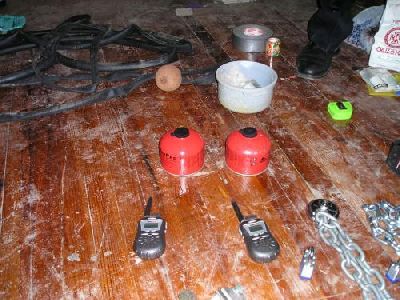
McGuire noted that solidarity among different sectors of the global justice movement was critical to off-setting the police intimidation tactics. The police used divide and conquer techniques, informing labor activists that their rally and march were threatened by the presence of direct action activists. As an example, McGuire highlighted the coordination between labor and direct action activists. The heavy handed methods used by police eventually back-fired, creating bonds of common experience among the diverse groups that constitute the global justice movement.
The Battle Phase The police used a massive show of force in Miami, and a wide variety crowd control weaponry. About 2,500 troops in heavy riot gear blocked cross-streets to Biscayne Boulevard, which led to the downtown area, thereby funneling all traffic to one entry point. As a result, many buses were turned back, denying many union members the opportunity to participate in their morning rally on November 20. The troops also cordoned off the demonstration area, confining demonstrators, preventing them from using port-a-potties, and denying additional union members access to their labor rally at the Bayside amphitheater. In doing so, the outdoor amphitheater remained half-empty as news media broadcast images, which gave national viewers the appearance of a poorly attended demonstration.
On the afternoon of November 20, after the labor march, police positioned themselves in lines to the North and South on Biscayne Blvd. Demonstrators positioned themselves in front of Southern line and chanted. McGuire shared a sequence of pictures, the first showing a woman named Nikki Hartman praying in front of the police line. Police began advancing on the demonstrators, and the sequence of photos show Nikki walking away from the police, being shot in the back, then crawling, and eventually bloodied by a head wound.
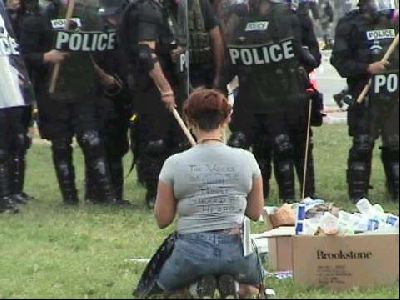
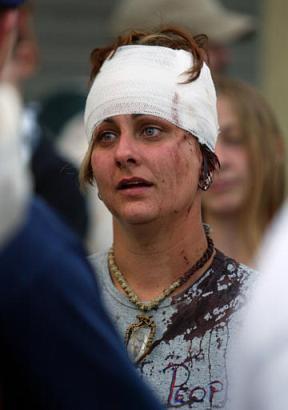
See Full Series of Hartman Photos
McGuire showed another notable picture of an injury inflicted by the police. In this case, Carl Kesser, a Miami documentary film maker, had a lead-shot filled "beanbag" projectile lodge up under his skin near his temple. At the time of his injury, Kesser was shooting video as an independent observer. The the right side of his face remains partially paralyzed and his right eyelid droops. According to someone claiming to be his son, the doctors said that Kesser was miraculously not blinded, and had the shot hit at another angle he could have been killed. This assessment is confirmed by Maj. Steve Ijames of the Springfield, Mo., police department. According to the Miami Herald, Ijames, an expert who, has testified in dozens of beanbag injury cases; "A lot of chest shots result in fatalities."
See Miami Herald 2/1/04 on Kesser
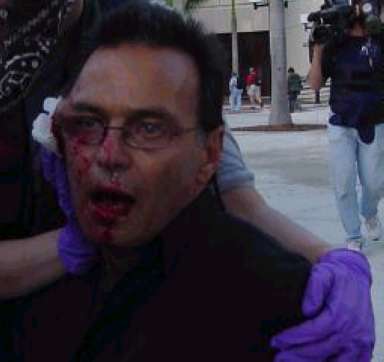
Global justice activists challenged this phase of the Miami Model in several ways. Volunteer street medics were present to provide routine first aid and to assist anyone injured by the police. A decontamination center was also set up in anticipation of the use of pepper spray, a goopy, sticky substance that burns the skin. Legal observers were present to document the police violence. Independent Media Center staff were also present to document the events. Their photos and videography often provide critical evidence to counter the post-protest phase of the Miami Model.
The Post-Protest Phase: Arrests, Detentions and the Judicial System The Miami Model doesn't stop with advance work, intimidation, and police use of force. McGuire recounted stories of neutral observers being arrested, including members of the media who were not embedded with the police. In a technique known to civil rights lawyers as “trap and arrest,” police give orders to disperse, and people find themselves surrounded by police with no exit route. This occurred to producer Ana Nogueira of the “Democracy Now!” radio program during the jail solidarity rally on November 21. “I was trying to get past them [the police], but they cut us off, surrounded us and pushed us into a corner very violently. They were beating people with batons and they pushed us up against a fence.” She went on to say, “They would tell us to get up and walk away and then push us down to the ground again.” “I was wearing my press ID. ... they didn't know what to do with me. One officer seemed uncertain as to whether he should arrest me or not until the other officers around him said 'she's not with us, she's not with us', [as in, she's not an embedded reporter] and they immediately arrested me.”
According to McGuire, "Before the mobilization we heard from a source inside the Police Department that the motto being used for the arrest
scenarios was 'You can beat the rap, but you can't beat the ride.' Meaning that the police planned on using groundless charges and putting people through the process as a punitive measure in and of itself. This is legally referred to as 'malicious prosecution' and is illegal."
In one example of this, the Associated Press reported January 29, 2004, "County Court Judge Beth Bloom granted a defense motion to dismiss charges Wednesday against Gan Golan, 30, [an MIT student] after hearing testimony and reviewing evidence from both sides. Bloom ruled that no reasonable juror could convict Golan based on what was presented." See Full AP Article
In a variant of this, an acquaintance of the author was temporarily detained by police on the street. As was common, he had his possessions confiscated. Upon release, he asked one releasing officer if he could retrieve his possessions. The officer said, "OK." Upon approaching the pile of people's personal items, he informed the officer near the pile, "I was told it was OK for me to get my things." To which this officer replied, "It's OK if you don't mind being beaten and arrested." This person choose to forfeit his possessions. In a similar situation, an someone reported that a local African American male came up to him and said something to the effect, "Hey. The Police said we could take your stuff, but we're not gonna, 'cuz we're with ya."
The jail detention process is another element of the Miami Model that authorities use. Police held people for hours without providing water or access to bathroom facilities. An AFL-CIO attorney described one “individual who's paid taxes all his life. ... fought in a war to defend this country. .. denied bathroom facilities, [he] faced the indignity of soiling himself.” In another case, Ana Nogueira was forced to strip off her clothes in front of male police officers to be decontaminated of pepper spray used by the police.
The Miami Model also makes use of the judicial system as a means of limiting dissent. As one technique, authorities reduced charges so they could invoke a rule that denies state-provided counsel the accused. Because many people traveled from out of state to participate in the demonstrations, the unprovoked arrests place a substantial burden on people to travel to Miami for court appearances. The use of unpredictable arrests, combined with the prospect of having to travel great distances for court appearances, is sure to dissuade people from participating in future mass demonstrations.
The global justice movement has also addressed this phase of the Miami Model. In anticipation of potential arrests, activists organize into affinity groups. Some members of of the groups stay far from areas of protest so that they can affect jail releases and conduct information campaigns on behalf of people who are held for extended periods. In addition, progressive legal advocates assist people who are arrested, and prepare law suits against the authorities for abuses of power
Closing Commentary
Many people familiar with the Miami Model tend to describe it in limited terms of the use of para-military police force during demonstrations. This article uses a chronological framework to characterize the Miami Model more broadly in terms of a system of integrated elements including propaganda, intimidation, brute force, arrest, detention, and use of the justice system.
This article also touches on a more subtle aspect of the Miami Model, the integration of corporate and governmental assets to limit political expression. Robert F. Kennedy, Jr. used the term “corporate fascism” in the Rolling Stone magazine, and was asked by Salon.com if he felt the term constituted “excessive rhetoric.” He responded, “No, I don't.” Kennedy went on to say, “The control of the capitalist system by large corporations leads to the elimination of markets and ultimately to the elimination of democracy.” Although this article only touches upon the subject, one might ask, “Would it be excessive rhetoric to say that the Miami Model is structurally integrated with corporate fascism?”
2003 will be marked as the year that the main stream media began to openly characterize the United States as an “Empire.” Perhaps 2004 will be the year that people begin to openly use the word “fascism” in the same sentence as the “United States.” Further use of the Miami Model in 2004 could lead us in that direction.
Background and coverage of the FTAA:
www.globalexchange.org/ftaa
www.ftaaimc.org
Police Chief Timoney:
ftaaimc.org/en/2003/11/2227.shtml
ftaaimc.org/en/2003/11/2073.shtml
Timoney & Beau Dietl & Associates (See Press Center for references to Timoney):
www.beaudietl.com
Timoney's 2002 Marketing visit to Boston (note the date: 11/20/02):
www.thebostonchannel.com/democraticconvention/1797909/detail.html
ACLU & Ordinance:
www.aclu.org/FreeSpeech/FreeSpeech.cfm
Robert Kennedy Jr on America's slide toward “corporate fascism”: www.salon.com/opinion/feature/2003/11/19/bobbykennedyjr/print.htmll
.
This piece is built upon a multi-media presentation given by Baltimore global justice movement activist Mike McGuire. He spoke at the People's Summit on January 24, 2004, sponsored by the University of Baltimore Progressives...See People's Summit article
In November 2003, international trade ministers met in Miami, Florida for negotiations on the proposed Free Trade Area of the Americas (FTAA). The FTAA would effectively expand the North American Free Trade Agreement (NAFTA) to cover the 34 countries in the Western Hemisphere, except Cuba.
Opposition to the FTAA is founded on a concern that these agreements are established by and for the interests of large multinational corporations without meaningful public involvement. These agreements institutionalize unfair advantages, which undermine social wellbeing. Current and future lives and livelihoods are at stake. These grave stakes justify street demonstrations, protected by basic democratic principles.
This is a story about how government and corporate entities collaborated to deny basic democratic rights of expression in Miami. Local, state and federal authorities used an integrated sequence of actions designed to undermine dissenting political voices before, during and after the FTAA demonstrations. Miami Mayor Manny Diaz called the actions “a model for homeland security.” Several cities sent law enforcement observers to Miami to study what some are now referring to as the “Miami Model.”
Many of the People's Summit workshop participants expressed being shocked by the new information they received in McGuire's presentation. A show of hands revealed that only a few, of about fifty people, were aware of the harsh realities that transpired in Miami. The void of meaningful news coverage is an indictment of the corporate media. During her speech at the recent World Social Forum, Arundhati Roy said, “It's important to understand that the corporate media don't just support the neoliberal project. They are the neoliberal project. This is not a moral position they have chosen to take; it's structural. It's intrinsic to the economics of how the mass media work.” This notion was cleverly exploited as part of the Miami Model.
The Miami Model Architect

John F. Timoney Miami Model Architect
The Miami Model was conceived and implemented by John F. Timoney. Timoney, presented by the media as “Miami Chief of Police,” was actually on temporary leave from Beau Dietl & Associates, an investigative and security corporation. This blurring of the line between the government and corporations is an unsettling trend, motivating people like Robert F. Kennedy Jr. to ponder the slide of America toward “corporate fascism.” McGuire described Timoney's controversial history, notably as Philadelphia Police Commissioner during the 2000 Republican National Convention. Timoney circumvented people's First Amendment rights by conducting preemptive arrests, later dropping the unsupportable charges. Timoney made a marketing visit to Boston in 2002 saying, "I can guarantee, spending a few million dollars extra ... is well worth it." That marketing visit paid off. He is reported to have been hired to implement the Miami Model during the 2004 Democratic National Convention in Boston.
Miami Model Overview
The Miami Model has similarities to the build-up and execution of the Iraq war. In the preparatory phase, authorities conducted a propaganda campaign to demonize the global justice movement as the enemy. Authorities further laid the groundwork by instituting new ordinances to limit protester's rights, and expand policing powers. Authorities also recruited embedded journalists, creating an elite strata that would be physically protected and separated from the unembedded journalists during the demonstrations. In the probing phase of the battle, authorities softened up the enemy by using intimidating harassment techniques. They also took steps to undermine protest organizer's logistical efforts. During the main battles, on November 20 and 21, authorities used an overwhelming force of well armed riot troops. The troops were placed on a hair trigger, nearly guaranteeing that their use of force would be unleashed on protesters, unembedded journalists, and anyone who happened to be in the area. During the mopping up phase, authorities used the arrest process, detentions, and the judicial system in ways calculated to maximize the punishment and deterrence value, while minimizing the authority's own legal exposure. As elaborated upon below, McGuire described how global justice activists strived to counter each phase of the Miami Model, and continue to do so in the legal arena and through public discourse.
Miami Model In-Depth
The Preliminary Phase About $8.5 million dollars was earmarked for FTAA security in the Bush administration's $87 billion dollar Iraq funding legislation. Among other things, this enabled police to implement an intense propaganda campaign to dehumanize the protesters in the minds of general community, local business people, and even hospital staff.
In another example of the corporate and government lines being blurred, police held a briefing for local business leaders that openly endorsed the controversial trade agreement. According to Salon.com, Deputy Police Chief Frank Fernandez told the audience that the FTAA would bring 89,000 new jobs to the area and add $13.5 billion annually to Florida's Gross State Product. According to Lida Rodriguez-Taseff of the ACLU, “the police went from being the neutral protector of liberty ... to being the enforcer of a political goal." “In situations where the police don't like the protesters' message, they definitely treat protesters as the enemy,” said Rodriguez.
According to McGuire, one injured protester reported receiving the cold shoulder from hospital workers. Eventually, a sympathetic hospital worker confided that the police had visited the hospital prior to the demonstrations. Police had warned the staff that they expected violent protesters, and that hospitals should be prepared to see blood. The propaganda campaign made people so anxious, McGuire reported, that some schools conducted “duck and cover” drills.
In another step to lay the groundwork, the Miami City Commission passed an ordinance designed to limit protest activities, and give police new powers to detain and arrest people. Passed just days before the demonstrations, the timing of the ordinance gave no opportunity to test its constitutionality before it was used to suppress dissenting voices. The ACLU challenged the ordinance as one that “criminalizes objects instead of actions.” The ordinance also included a very broad definition of an “assembly,” a provision that was exploited by police to a chilling effect.
Event planners also reported threats of selective enforcement of zoning ordinances to undermine their organizing efforts. Churches and other community groups were told that they risked citations if they allowed global justice activists to use their facilities for housing.
Fortunately, global justice activists arrived weeks in advance of the main events and took steps to off-set the propaganda campaign. McGuire described how about fifty global justice organizers visited local business people to explain their opposition the FTAA and allay business people's concerns about property damage. The business people informed the organizers about the police propaganda campaign, and some business people responded positively by placing anti-FTAA posters in their windows. Some of these posters were confiscated by police.
Activists distributed about 100 cherry tree seedlings among the residents of Over Town, the predominantly African American neighborhood on the Western boarder of downtown Miami. Others volunteered time to work in urban community gardens, and still others set up a colorful “Free Carnival Area of the Americas” to create a non-threatening forum for interaction with the community. People who organized an Independent Media Center (IMC) for the events invited some school children to visit their center. McGuire read part of a thank-you letter from one of the student visitors who said, “The [IMC] people that shared the information were very welcoming and informative. We thought there was going to be fighting and rioting, but it was very calm and peaceful. We enjoyed our experience here.”
Pre-Battle Harassment and Intimidation Phase In the weeks leading up to the main events, global justice activists, journalists and curious onlookers were harrased by police. Stories abound of people being stopped, searched, told to stop taking notes, video, photographs, or any number of things commonly associated with freedom of speech, of the press and of assembly. Upon the author's arrival in Miami, shaken activists reported seeing video of what police had done to a person's parked car that was deemed to be suspicious. A witness said, “I walked by and spoke to Juan [the car owner] and saw the damage: two broken windows, a hole drilled in the trunk and they drilled through a door. He said the cops told him there was a 5 gallon bucket of paint in the back seat so they had to do this.” “No FTAA” bumper stickers were on the car.
Some people who distributed educational literature to local businesses were detained and several were arrested. McGuire, who was in Miami in the weeks before, described routinely being followed down the street by police cruisers at walking speed. He also told of an almost comical scene in which about eight police cars followed activists on bicycles. The bicyclists led police through parks, down alleys in an eye-rolling cat and mouse game. In another case, the police arrested seven people in a mansion where they were squatting. Police declared that they had uncovered materials for “incendiary devices.” McGuire showed a picture of the items assembled by police, which included two small cylinders of cooking fuel, inner tubes, bike locks, a couple of walkie talkies, a coconut, and little else. In this case the police, with assistance from MSNBC and other mass media, efficiently combined harassment and demonization.
Click on image for a larger version

Items portrayed by police as materials for making incendiary devices
McGuire noted that solidarity among different sectors of the global justice movement was critical to off-setting the police intimidation tactics. The police used divide and conquer techniques, informing labor activists that their rally and march were threatened by the presence of direct action activists. As an example, McGuire highlighted the coordination between labor and direct action activists. The heavy handed methods used by police eventually back-fired, creating bonds of common experience among the diverse groups that constitute the global justice movement.
The Battle Phase The police used a massive show of force in Miami, and a wide variety crowd control weaponry. About 2,500 troops in heavy riot gear blocked cross-streets to Biscayne Boulevard, which led to the downtown area, thereby funneling all traffic to one entry point. As a result, many buses were turned back, denying many union members the opportunity to participate in their morning rally on November 20. The troops also cordoned off the demonstration area, confining demonstrators, preventing them from using port-a-potties, and denying additional union members access to their labor rally at the Bayside amphitheater. In doing so, the outdoor amphitheater remained half-empty as news media broadcast images, which gave national viewers the appearance of a poorly attended demonstration.
On the afternoon of November 20, after the labor march, police positioned themselves in lines to the North and South on Biscayne Blvd. Demonstrators positioned themselves in front of Southern line and chanted. McGuire shared a sequence of pictures, the first showing a woman named Nikki Hartman praying in front of the police line. Police began advancing on the demonstrators, and the sequence of photos show Nikki walking away from the police, being shot in the back, then crawling, and eventually bloodied by a head wound.
Click on image for a larger version

Nikki Hartman Praying in front of Police Line at FTAA Demonstration

Nikki Hartman after receiving first aid treatment
See Full Series of Hartman Photos
McGuire showed another notable picture of an injury inflicted by the police. In this case, Carl Kesser, a Miami documentary film maker, had a lead-shot filled "beanbag" projectile lodge up under his skin near his temple. At the time of his injury, Kesser was shooting video as an independent observer. The the right side of his face remains partially paralyzed and his right eyelid droops. According to someone claiming to be his son, the doctors said that Kesser was miraculously not blinded, and had the shot hit at another angle he could have been killed. This assessment is confirmed by Maj. Steve Ijames of the Springfield, Mo., police department. According to the Miami Herald, Ijames, an expert who, has testified in dozens of beanbag injury cases; "A lot of chest shots result in fatalities."
See Miami Herald 2/1/04 on Kesser

Carl Kesser, Miami documentary film maker, with a projectile lodged under the skin near his temple.
Global justice activists challenged this phase of the Miami Model in several ways. Volunteer street medics were present to provide routine first aid and to assist anyone injured by the police. A decontamination center was also set up in anticipation of the use of pepper spray, a goopy, sticky substance that burns the skin. Legal observers were present to document the police violence. Independent Media Center staff were also present to document the events. Their photos and videography often provide critical evidence to counter the post-protest phase of the Miami Model.
The Post-Protest Phase: Arrests, Detentions and the Judicial System The Miami Model doesn't stop with advance work, intimidation, and police use of force. McGuire recounted stories of neutral observers being arrested, including members of the media who were not embedded with the police. In a technique known to civil rights lawyers as “trap and arrest,” police give orders to disperse, and people find themselves surrounded by police with no exit route. This occurred to producer Ana Nogueira of the “Democracy Now!” radio program during the jail solidarity rally on November 21. “I was trying to get past them [the police], but they cut us off, surrounded us and pushed us into a corner very violently. They were beating people with batons and they pushed us up against a fence.” She went on to say, “They would tell us to get up and walk away and then push us down to the ground again.” “I was wearing my press ID. ... they didn't know what to do with me. One officer seemed uncertain as to whether he should arrest me or not until the other officers around him said 'she's not with us, she's not with us', [as in, she's not an embedded reporter] and they immediately arrested me.”
According to McGuire, "Before the mobilization we heard from a source inside the Police Department that the motto being used for the arrest
scenarios was 'You can beat the rap, but you can't beat the ride.' Meaning that the police planned on using groundless charges and putting people through the process as a punitive measure in and of itself. This is legally referred to as 'malicious prosecution' and is illegal."
In one example of this, the Associated Press reported January 29, 2004, "County Court Judge Beth Bloom granted a defense motion to dismiss charges Wednesday against Gan Golan, 30, [an MIT student] after hearing testimony and reviewing evidence from both sides. Bloom ruled that no reasonable juror could convict Golan based on what was presented." See Full AP Article
In a variant of this, an acquaintance of the author was temporarily detained by police on the street. As was common, he had his possessions confiscated. Upon release, he asked one releasing officer if he could retrieve his possessions. The officer said, "OK." Upon approaching the pile of people's personal items, he informed the officer near the pile, "I was told it was OK for me to get my things." To which this officer replied, "It's OK if you don't mind being beaten and arrested." This person choose to forfeit his possessions. In a similar situation, an someone reported that a local African American male came up to him and said something to the effect, "Hey. The Police said we could take your stuff, but we're not gonna, 'cuz we're with ya."
The jail detention process is another element of the Miami Model that authorities use. Police held people for hours without providing water or access to bathroom facilities. An AFL-CIO attorney described one “individual who's paid taxes all his life. ... fought in a war to defend this country. .. denied bathroom facilities, [he] faced the indignity of soiling himself.” In another case, Ana Nogueira was forced to strip off her clothes in front of male police officers to be decontaminated of pepper spray used by the police.
The Miami Model also makes use of the judicial system as a means of limiting dissent. As one technique, authorities reduced charges so they could invoke a rule that denies state-provided counsel the accused. Because many people traveled from out of state to participate in the demonstrations, the unprovoked arrests place a substantial burden on people to travel to Miami for court appearances. The use of unpredictable arrests, combined with the prospect of having to travel great distances for court appearances, is sure to dissuade people from participating in future mass demonstrations.
The global justice movement has also addressed this phase of the Miami Model. In anticipation of potential arrests, activists organize into affinity groups. Some members of of the groups stay far from areas of protest so that they can affect jail releases and conduct information campaigns on behalf of people who are held for extended periods. In addition, progressive legal advocates assist people who are arrested, and prepare law suits against the authorities for abuses of power
Closing Commentary
Many people familiar with the Miami Model tend to describe it in limited terms of the use of para-military police force during demonstrations. This article uses a chronological framework to characterize the Miami Model more broadly in terms of a system of integrated elements including propaganda, intimidation, brute force, arrest, detention, and use of the justice system.
This article also touches on a more subtle aspect of the Miami Model, the integration of corporate and governmental assets to limit political expression. Robert F. Kennedy, Jr. used the term “corporate fascism” in the Rolling Stone magazine, and was asked by Salon.com if he felt the term constituted “excessive rhetoric.” He responded, “No, I don't.” Kennedy went on to say, “The control of the capitalist system by large corporations leads to the elimination of markets and ultimately to the elimination of democracy.” Although this article only touches upon the subject, one might ask, “Would it be excessive rhetoric to say that the Miami Model is structurally integrated with corporate fascism?”
2003 will be marked as the year that the main stream media began to openly characterize the United States as an “Empire.” Perhaps 2004 will be the year that people begin to openly use the word “fascism” in the same sentence as the “United States.” Further use of the Miami Model in 2004 could lead us in that direction.
Background and coverage of the FTAA:
www.globalexchange.org/ftaa
www.ftaaimc.org
Police Chief Timoney:
ftaaimc.org/en/2003/11/2227.shtml
ftaaimc.org/en/2003/11/2073.shtml
Timoney & Beau Dietl & Associates (See Press Center for references to Timoney):
www.beaudietl.com
Timoney's 2002 Marketing visit to Boston (note the date: 11/20/02):
www.thebostonchannel.com/democraticconvention/1797909/detail.html
ACLU & Ordinance:
www.aclu.org/FreeSpeech/FreeSpeech.cfm
Robert Kennedy Jr on America's slide toward “corporate fascism”: www.salon.com/opinion/feature/2003/11/19/bobbykennedyjr/print.htmll
Views
Information
Search
This site made manifest by dadaIMC software


